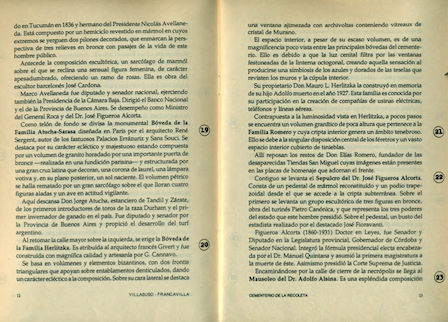
The difficulties of researching Recoleta Cemetery have been well documented in this blog. Whether due to copyright infringement, repetition of hearsay or even pure invention, all these problems present a disservice to one of the most spectacular sites of Buenos Aires.
Perhaps the most difficult issue to overcome is access to previous publications about the cemetery. Print runs in Argentina are notoriously small, often around 3,000 copies… in a capital city with almost 15 million people & a national population of 45 million! During the 14 years I lived there, I’d scout bookstores each month with the hope of obtaining new resources before they disappeared from sight. Much like a treasure hunt —fun but not practical for most researchers.

Libraries presented another problem: source material spread across the entire city with incomplete collection catalogs. After finding a good publication, I would scour the bibliography for additional leads. However, sources mentioned were often unavailable, in private collections or worse, completely missing. Also, most library staff had insufficient knowledge of holdings or lacked initiative to help users discover additional information. Budget cuts also affected operating hours. Navigating the system took more time than actual reading!
Fortunately the digital age has improved the availability of early texts about Recoleta Cemetery. A recent search on Scribd revealed two gems from the 1990s that I never found in physical form…

Although without a publication date, Recoleta: Cementerio, Arte e Historia contains a prologue signed by Fernando de la Rúa… acting as head of the Buenos Aires city government. That means this 36-page booklet had to be published sometime between 1996 & 1999. Also oddly missing is the author’s name; credit goes to a large number of public officials.
What a shame this publication was not reedited or reproduced in later years! I would have loved an introduction like this on my first cemetery visit. After a brief overview, a hand-drawn map —with correct dimensions— marks 50 tombs of interest. If the route were followed by number, quite a bit of backtracking would be involved. But that’s a minor issue.

Text for each point of interest is brief but with good & surprisingly neutral information about people who were often anything but neutral 😉 Interesting photographs accompany most descriptions. An updated version of this guide in several languages would have been a best-seller at the cemetery entrance gate during the tourism boom of the early 2000s:


Unfortunately this publication has been delegated to the city government’s library & will likely never return.

Issue #5 published by the Board of Historic Studies of Recoleta (Junta de Estudios Históricos de La Recoleta) had a complicated title… something akin to “Recoleta Cemetery: Unraveling its Sites”. The 1970s witnessed a birth of local historical associations, often composed of self-appointed elite who supported a particular vision of their neighborhood. Cemetery heritage director Carlos Francavilla co-authored this 42-page booklet with architect Victor Villasuso. 63 points of interest dot their map marked with a very clear walking route:

Descriptive text & photographs do not mingle; each have their own dedicated pages. In general, mausoleums receive elaborate architectural explanations —so much so that a glossary is included at the end— while occupants & their deeds are secondary.


While interesting for its choice of mausoleums (several of which are rarely mentioned in other guidebooks), overly simple design makes this publication difficult to use as does such grandiloquent language. Oddly cropped photographs also fail to highlight the beauty of mausoleums. Consider this a secondary resource for those interested in lengthy architectural descriptions rather than a practical guide.
Be First to Comment